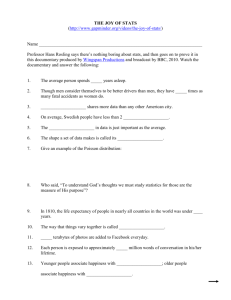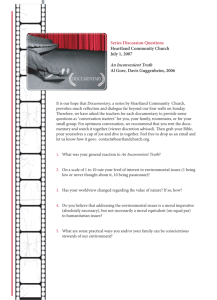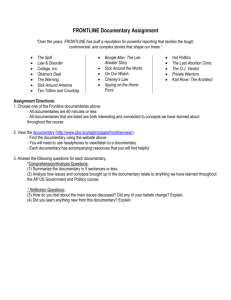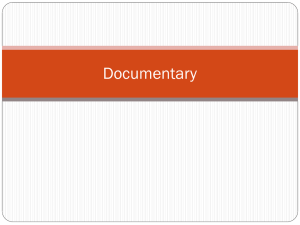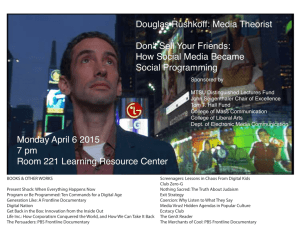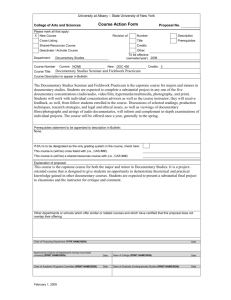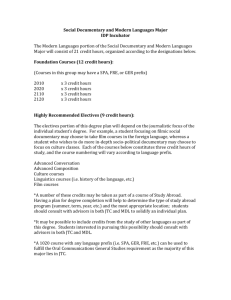example - Tom March
advertisement
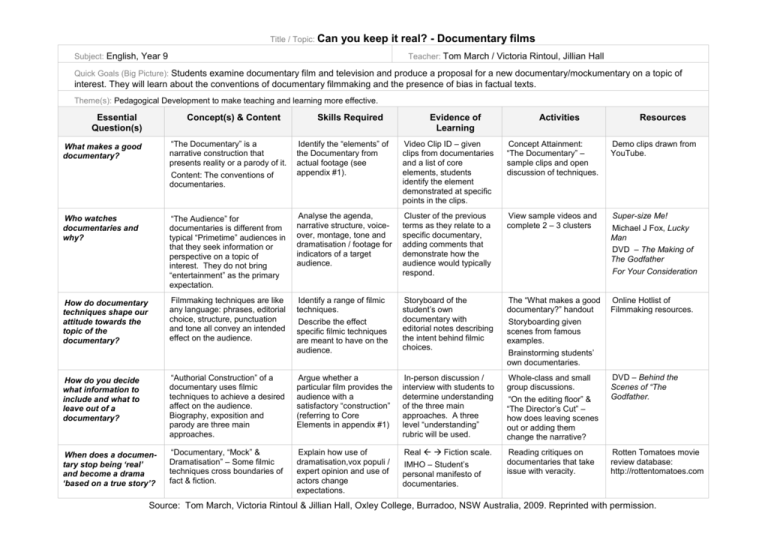
Title / Topic: Can you keep it real? - Documentary films Subject: English, Year 9 Teacher: Tom March / Victoria Rintoul, Jillian Hall Quick Goals (Big Picture): Students examine documentary film and television and produce a proposal for a new documentary/mockumentary on a topic of interest. They will learn about the conventions of documentary filmmaking and the presence of bias in factual texts. Theme(s): Pedagogical Development to make teaching and learning more effective. Essential Question(s) Concept(s) & Content Skills Required Evidence of Learning Activities Resources “The Documentary” is a narrative construction that presents reality or a parody of it. Content: The conventions of documentaries. Identify the “elements” of the Documentary from actual footage (see appendix #1). Video Clip ID – given clips from documentaries and a list of core elements, students identify the element demonstrated at specific points in the clips. Concept Attainment: “The Documentary” – sample clips and open discussion of techniques. Demo clips drawn from YouTube. Who watches documentaries and why? “The Audience” for documentaries is different from typical “Primetime” audiences in that they seek information or perspective on a topic of interest. They do not bring “entertainment” as the primary expectation. Analyse the agenda, narrative structure, voiceover, montage, tone and dramatisation / footage for indicators of a target audience. Cluster of the previous terms as they relate to a specific documentary, adding comments that demonstrate how the audience would typically respond. View sample videos and complete 2 – 3 clusters Super-size Me! Michael J Fox, Lucky Man DVD – The Making of The Godfather For Your Consideration How do documentary techniques shape our attitude towards the topic of the documentary? Filmmaking techniques are like any language: phrases, editorial choice, structure, punctuation and tone all convey an intended effect on the audience. Identify a range of filmic techniques. Describe the effect specific filmic techniques are meant to have on the audience. Storyboard of the student’s own documentary with editorial notes describing the intent behind filmic choices. The “What makes a good documentary?” handout Storyboarding given scenes from famous examples. Brainstorming students’ own documentaries. Online Hotlist of Filmmaking resources. “Authorial Construction” of a documentary uses filmic techniques to achieve a desired affect on the audience. Biography, exposition and parody are three main approaches. Argue whether a particular film provides the audience with a satisfactory “construction” (referring to Core Elements in appendix #1) In-person discussion / interview with students to determine understanding of the three main approaches. A three level “understanding” rubric will be used. Whole-class and small group discussions. “On the editing floor” & “The Director’s Cut” – how does leaving scenes out or adding them change the narrative? DVD – Behind the Scenes of “The Godfather. “Documentary, “Mock” & Dramatisation” – Some filmic techniques cross boundaries of fact & fiction. Explain how use of dramatisation,vox populi / expert opinion and use of actors change expectations. Real Fiction scale. IMHO – Student’s personal manifesto of documentaries. Reading critiques on documentaries that take issue with veracity. Rotten Tomatoes movie review database: http://rottentomatoes.com What makes a good documentary? How do you decide what information to include and what to leave out of a documentary? When does a documentary stop being ‘real’ and become a drama ‘based on a true story’? Source: Tom March, Victoria Rintoul & Jillian Hall, Oxley College, Burradoo, NSW Australia, 2009. Reprinted with permission. Title / Topic: Can you keep it real? - Documentary films Appendix #1 Elements of “The Documentary” Common Elements – narrative structure – titles, chapter headings and sequencing – montage – interview: vox populi/expert opinion – tone and register – jargon and technical language – walk through – work in progress Biographies – images (cover/within book) – quotations and statistics used to support judgements – anecdotes Documentaries – voice over – dramatisation/re-enactment – selection of original footage/images/music – process with narration Parodies – voice over using overstatement/understatement – actors rather than experts – humorous dramatisation – incongruous music/images – satire Stage 5 English Outcomes: 1. responds to and composes increasingly sophisticated and sustained texts for understanding, interpretation, critical analysis and pleasure 2. uses and critically assesses a range of processes for responding and composing 3. selects, uses, describes and explains how different technologies affect and shape meaning 4. selects and uses language forms and features, and structures of texts according to different purposes, audiences and contexts, and describes and explains their effects on meaning 5. transfers understanding of language concepts into new and different contexts 6. experiments with different ways of imaginatively and interpretively transforming experience, information and ideas into texts 7. thinks critically and interpretively using information, ideas and increasingly complex arguments to respond to and compose texts in a range of contexts 8. investigates the relationships between and among texts 9. demonstrates understanding of the ways texts reflect personal and public worlds 10. questions, challenges and evaluates cultural assumptions in texts and their effects on meaning 11. uses, reflects on, assesses and adapts their individual and collaborative skills for learning with increasing independence and effectiveness Source: Tom March, Victoria Rintoul & Jillian Hall, Oxley College, Burradoo, NSW Australia, 2009. Reprinted with permission.

